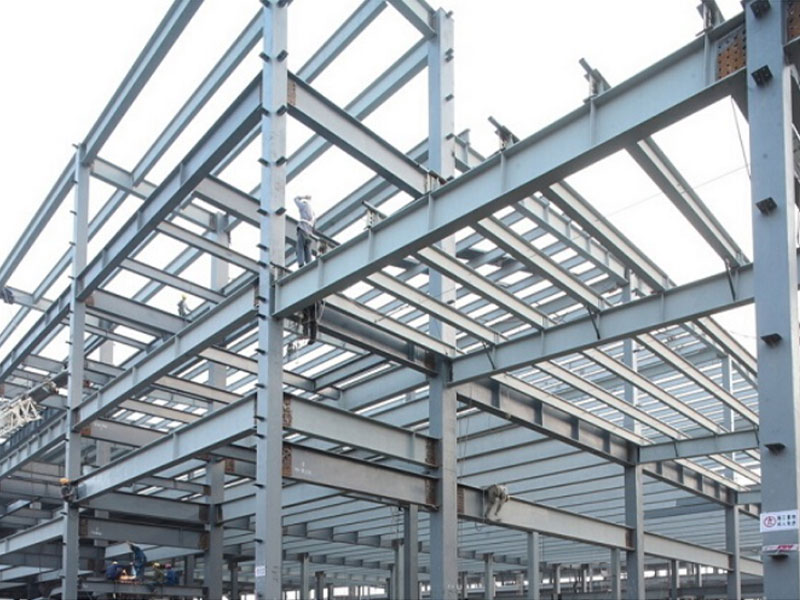

Steel construction is a structural member assembled by mechanical processing with steel as the base material.
Steel is much stronger than other building materials such as concrete, masonry and wood. Therefore, it is especially suitable for members and structures with large spans or large loads. Steel is also characterized by good plasticity and ductility. Good plasticity, the structure will not suddenly fracture under normal conditions due to overload; good toughness, the structure is highly adaptable to dynamic loads. Good energy absorption capacity and ductility also make the steel structure have superior seismic performance.
Although the density of steel is greater than that of concrete and other building materials, steel structures are lighter than reinforced concrete structures because the ratio of strength to density of steel is much greater than that of concrete. With the same span to bear the same load, the mass of steel roof frame is at most 1/3 to 1/4 of reinforced concrete roof frame, and the cold-formed thin-walled steel roof frame is even close to 1/10, which provides convenient conditions for lifting.

The materials used in steel constructions are simple and ready-made, relatively easy to process, and can be operated mechanically. Therefore, a large number of Steel construction are generally made into components in specialized metal structure factories with high accuracy. The components can be assembled on site with simple common bolts and high-strength bolts, and sometimes they can be assembled and welded into larger units on the ground and then lifted to shorten the construction period. Small amount of steel structure and light steel roof frame can also be manufactured in situ on site and lifted with simple machines. In addition, it is also easier to alter and reinforce the completed steel structure, and the bolted structure can be dismantled as needed.
Steel has relatively poor corrosion resistance and attention must be paid to the protection of the structure. This makes the maintenance cost higher than that of reinforced concrete structures. However, in general plants without aggressive media, the components are thoroughly descaled and painted with qualified paint, and rusting is not a serious problem. Atmospheric corrosion-resistant steel with better rust resistance has emerged in recent years and has been gradually promoted for use.
Steel is subjected to 100℃ radiation heat for a long time, the strength does not change much and has certain heat resistance, but when the temperature reaches 150℃ or more, it must be protected by heat insulation. Steel has poor fire resistance, and the strength of the material is obviously reduced when the temperature rises, so it is necessary to add fireproof coating or outsource concrete.
Low hardness after quenching: mainly due to low concentration of deep surface carbon or surface decarburization; quenching process is unreasonable, not quenched on fire or too much residual austenite, B carburizing depth is not enough: mainly low furnace temperature, short time, or poor circulation of the atmosphere in the furnace, the surface of the part is not clean, the carbon potential is too high workpiece surface carbon; improve the carburizing temperature and time, clean the surface of the workpiece before loading the furnace, reasonable control of carbon potential. c carburizing layer The appearance of large chunks of Wang Zhuang carbide; mainly carburizing surface carbon concentration is too high, reduce the carburizing agent activity, strict control of carbon potential.
Automobile, tractor gears selected 20CrMnTi material, its processing process route is: down forging normalizing machining carburizing, quenching + low temperature tempering shot peening grinding finished products, try to analyze the role of each heat treatment process.
Normalizing – eliminate forging stress, make the organization uniform, adjust the hardness to improve the machinability.
Carburizing – to improve the concentration of carbon on the tooth surface, (0.8~1.05%C)
Quenching – to improve the hardness of tooth surface and obtain a certain depth of hardened layer, so that the surface gets M tempering + alloy carbide + γ
With high hardness (58~62HRC), high wear resistance, higher strength and certain toughness. Improve the tooth surface wear resistance and contact fatigue strength, the heart of the tooth to get M tempering + F, with high toughness.
Low temperature tempering – eliminate quenching stress, prevent grinding cracks and improve impact resistance.

For Further Details,Please Feel Free To Contact Us: